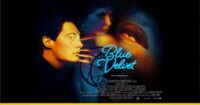By the late 1960s, the career of Federico Fellini had taken a rather peculiar turn. Up to this point in the decade, all his films had taken on some autobiographical aspect of either himself (a reporter in La Dolce Vita, a film director in 8½) or in the case of Juliet of the Spirits, Fellini’s marriage to his wife, Giulietta Masina.
After Juliet, Fellini tried to get his dream project Il viaggio di G. Mastorna made, but due to Juliet’s poor reception and the fact that the director had several dreams about death while preparing the film which he admitted spooked him, the movie was abandoned. After a hospital stay, Fellini decided Il viaggio could not be made so he focused his attention on Satyricon, which he read and had sparked his imagination during his recovery. His script (in collaboration with Bernardino Zapponi) was loosely adapted from The Satyricon, a Latin work of fiction by Gaius Petronius Arbiter (27–66 AD). In between Juliet and Satyricon, Fellini also made Toby Dammit for the anthology film, Spirits of the Dead, which is discussed here.
Encolpius (Martin Potter) screams in rage at the realization that his former friend Ascyltus took young Giton away from him.A year before Fellini filmed his movie, a cheapo Italian version of The Satyricon was rushed out directed by Gian Luigi Polidoro, featuring a young wide-eyed American actress named Tina Aumont (who would, in fact, go on to co-star in Fellini’s Casanova a few years later). Because Fellini wanted to avoid confusion, he added his name to the official title of his film. This would continue with Fellini’s Roma, Fellini’s Amarcord and Fellini’s Casanova, but with Orchestra Rehearsal (1978), he stopped adding his name to his film titles. Not that they needed it because when one watches a Fellini film, it’s unmistakable whose mind the vision came from.
Fellini Satyricon begins with a young scholar named Encolpius (Martin Potter), raging in front of a graffiti-colored wall over the fact his former friend, Ascyltus (Hiram Keller), stole away the young boy, Giton (Max Born), whom they both love and share. Encolpius screams for Ascyltus to present himself so that the two can battle for the young androgynous Giton, who has actually been sold to the gluttonous Vernacchio—a boorish actor/comedian who performs violent theater pieces in the name of Caesar.
The three young leads—Encolpius, Ascyltus, and Giton—are all impossibly young and good-looking with piercing eyes, trim and toned physiques, and the air of reckless youth about them. If this movie were to be made today, one could imagine it starring Jude Law as Encolpius, Ian Somerhalder as Ascyltus, and young Timothée Chalamet as the flowery Giton.
Encolpius (Martin Potter) attempts to convince Vernacchio (Fanfulla) to return young Giton (Max Born) to him.After a confrontation with Vernacchio (Fanfulla), who only releases young Giton when a magistrate of Caesar’s orders him to, Ascyltus and Giton return to their city street which is one of the most bizarre set-pieces likely ever witnessed on film. The sets, realized by Danilo Donati, are among some of the most visually striking ever built for cinema. These scenes set in the Insula Felicles, a Roman tenement building, and the otherworldly inhabitants of them who dwell in stony doorless huts have obviously inspired future films such as Blade Runner, Mad Max: Beyond Thunderdome, and even the Star Wars prequels. This sequence is quite possibly one of the most outrageous of Fellini’s entire catalogue. The film also achieves greatness due to Giuseppe Rotunno’s incredible cinematography, with its blood orange skies and many scenes of fire and streams of water as sources of light.
When Ascyltus returns, young Giton chooses to go with him, leaving Encolpius devastated. As if working in tandem with the young student’s crumbling heart, the entire tenement building also crumbles. Encolpius winds up in the gallery of a poet and artist named Eumolpus (Salvo Randone), where they are invited to attend a feast thrown by the gluttonous Trimalchio (Mario Romagnoli) and his wife Fortunata (played by Fellini favorite Magali Noel). This sequence is the centerpiece of Satyricon. This is where the excesses of the wealthy Roman’s clash with the culture learned by the idealist youth. The artistic nature of young Encolpius that embraces a thirst for literature and art clashes with the uncouth, sloth-like, overindulgence of the old, jowly, tired-looking can-have anything-he-wants-on-command lifestyle of Trimalchio. When Eumolpus attempts to inject a little class into the gathering with some poetry, he is silenced by being on the receiving end of globs of orange and brown mush all to the delight of the sneering host.
Encolpius and Eumolpus partake in the bountiful excess of Trimalchio’s feast until the crowd turns.Star Wars fans may note the similarities between Trimalchio and Return of the Jedi’s Jabba the Hutt. Both are, of course, boorishly yellow-eyed mounds of gluttony with little regard for the weaker or poor among them (and the name of Trimalchio’s wife, Fortunata, sounds suspiciously similar to Jabba’s right-hand, Bib Fortuna). Fellini has described this film as a “science-fiction” film, only one that takes place a long time ago not in a galaxy far, far away, but of a world not too far off from one that may actually have existed.
In a further attack on Eumolpus, Trimalchio has the poet dragged off and beaten. Encolpius helps the injured scholar across the desert to a pool of water where the elder man bequeaths the gift of poetry on the younger man—it does little good as both are kidnapped the next morning and imprisoned on a ship owned by Lichas (Alain Cuny playing the role after Americans Danny Kaye and even Groucho Marx turned it down). Here, Encolpius is reunited with Ascyltus and Giton, who have also been captured. After proving his might in a wrestling dual, Lichas takes a shine to Encolpius and weds him with the blessing of his wife, Tryphaena (played by French model and The Pink Panther actress Capucine). Lichas is a treacherous and murderous transvestite who is quickly beheaded when Roman soldiers take over the ship.
Encolpius “marries” Lichas on a Roman pirate ship at sea, but the union does not last long.An oncoming ship, this one carrying an effeminate young Caesar, approaches but the emperor flees his ship only to be confronted by Roman soldiers. After the emperor then takes his own life, the Romans board Lichas’ barque and promptly beheads him. With Lichas gone (much to the pleasure of Tryphaena), Encolpius and Ascyltus are free again. They find themselves on a deserted villa with only a young African slave girl (Hylette Adolphe), whom they take to bed. The next day, they meet a bearded stranger with an ill wife who convinces them to kidnap a demigod hermaphrodite with life-healing powers, who dies during their desert flight. The duo are captured once again where during a festival of the god Laughter, Encolpius is trapped in a maze where the young blonde student must battle a muscular Minotaur. After being spared, Ascyltus attempts to make love to the sensual female, Ariadne, in front of the roaring crowd—but he cannot.

Encolpius is cursed with impotence and learns that only a beautiful young woman Oenothea (Donyale Luna, who made history a few years earlier as the first African-American woman to appear on the cover of Vogue), who has had a curse put on her by an old wizard, can cure Encolpius of his ailment. Oenothea has the ability to light fire from her genital area. When Encolpius visits the woman, she is no longer young or beautiful, but this matters not to the desperate young man. While crying to the gods to heal him of his condition, he observes Ascyltus cavorting with a half-dozen females lying at his feet on a giant swing, which just agonizes Encolpius even more.
Fellini presents a society where the ability to indulge in one’s lustful desires is all that matters. There’s sexual lust of course, but also lust for food, poetry, power, riches and lust for survival. Encolpius regains his ability to perform sexually while Ascyltus loses the lust to fight and ultimately meets his end after a soldier’s attack. Encolpius has regained his sexual prowess but he’s lost Ascyltus, Eumolpus and Giton (who isn’t seen again after the Lichas segment). With nothing left for him in ancient Rome, here his journey ends as the young student/lover/now fighter embarks on a voyage ship to North Africa.
Fellini Satyricon has been described as being 20 per cent Petronius and 80 per cent Fellini. It’s said that the 20 per cent was written by co-screenwriter Zapponi and the rest by Fellini. It has also been described as a “sexual odyssey” and that is a very telling description considering that this film was aimed at the same movie-going hippie audience who tripped out while viewing the sequence in Stanley Kubrick’s 2001: A Space Odyssey. It has also been called a “homosexual odyssey” by the director himself, which is another accurate description in that virtually every character is homosexual or bisexual. That Fellini had to set his story 2000 years in the past in order to pull it off is quite telling about the morals in Italy at the time. This also explains why his three main principle actors—Potter, Hiram, and Born—are from London and America.
Encolpius and Ascyltus are weary after their experiences in SatyriconIt’s worth noting that Satyricon is actually the first film in over a decade where Fellini has featured young people as the main subjects—something he hasn’t explored since I Vitelloni 16 years earlier. All his other films of the previous decade have featured characters closer to middle age. Perhaps something was stirring inside Fellini to return to the spirit of reckless youth, living wildly without boundaries or limits and Satyricon is one of the greater examples of this in film history. Incidentally, Fellini would further explore aspects of his youth in the three films he made during the first half of the ’70s (I clowns, Roma, and Amarcord). Fellini was nearing 60 years old while making Satyricon, but the movie is alive with the lust for life (to coin a phrase from Iggy Pop) of youthful appetites and the decline of culture and literature. The crowd gathered at Trimalchio’s feast shows more glee over the excesses presented to them (food, wine, gold) than in Eumolpus’ poetry. The message is clear: greed and excess—good. Culture and enlightenment—not.
Upon its release, Satyricon was criticized for the blatant homosexuality and bisexuality on display throughout. Fellini scoffed at those critics publicly and even confounded a few by teasing them that they were wrong in asserting his previous films were the true autobiographical films, whereas this one was actually his most autobiographical movie to date. Perhaps, privately the criticism did leave a mark because his next major films (Amarcord, Casanova, City of Women) feature males (young and older) consumed by the thoughts of women and chasing them.
With Satyricon closing out the decade (the film premiered in Italy in late 1969 and opened in America in March 1970), Fellini had created a collection of movies that defined Italian cinema over the course of 10 years. The four full-length features (and two shorter anthology films) he made and released during this period present an Italy that has changed incredibly during this period. You can almost switch the last movie he made in the decade, Satyricon, with the one he made at the beginning of it, La Dolce Vita, as both explore some of the same themes: modern-day worship of glamor, riches, the polished, the sweet life (or “dolce vita” in Italian) above intelligence, knowledge and a deeper examination and exploration of life and humans. The wild, orgiastic party which concludes La Dolce Vita, attended by homosexuals, nymphomaniacs and strippers and other types could easily fit into any part of Satyricon. Society has not evolved over the centuries. The only difference is that while Satyricon’s revelry took place in huts of stone, mud and grass lit only by firelight and that story’s characters wear the basest of garments and sandals, in La Dolce Vita they take place in opulent, hillside penthouses where its male attendees dress in Piero Gherardi tuxedos and the women in Balenciaga dresses. La Dolce Vita’s Marcello—lost after a wild night of debauchery and drunken excess—would fit right in with the unruly inhabitants of Satyricon. The main characters of both films wind up empty, adrift and unsure of what future awaits them. In a word, they are purposeless.
The drawn images of the characters of Satyricon displayed on a fresca in the last moments of the film as Encolpius has set sail for North AfricaLa Dolce Vita and Satyricon are bookends to a decade where Fellini established himself as the leading author of Italian cinema in the 1960s. By the end of these two landmark films, both Marcello and Encolpius are worn and tired from pursuing education and then chasing after their primal lusts. It seems things have changed little in 2000 years. Perhaps this is why in 8½, a film Fellini made between these two, is that film’s hero, film director Guido Anselmi, wishes to make an actual science fiction movie. Well, Guido didn’t get to make his grand Italian science fiction film to comment on modern-day Italy, but in 1969, Fellini did.


